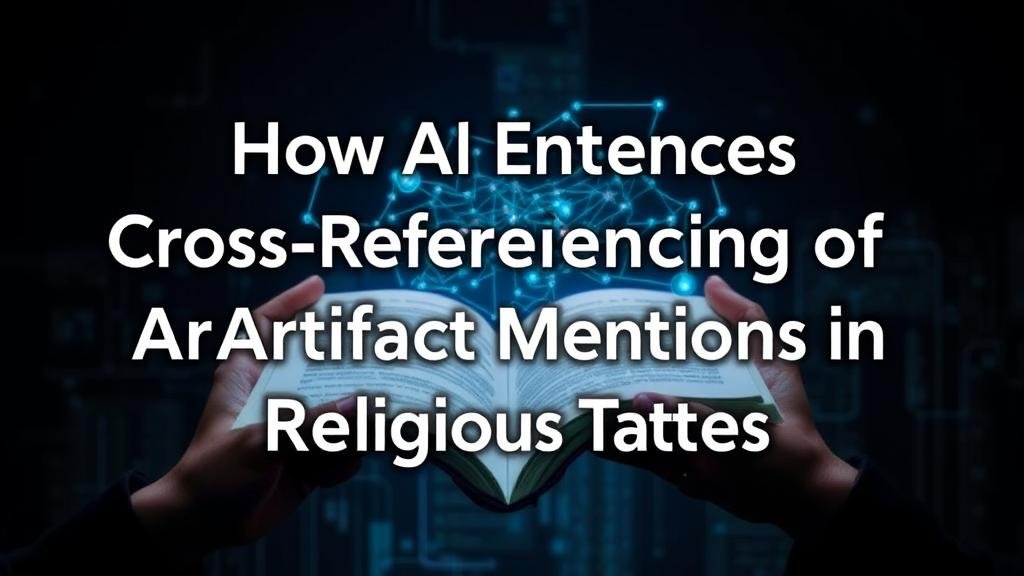How AI Enhances Cross-Referencing of Artifact Mentions in Religious Texts
How AI Enhances Cross-Referencing of Artifact Mentions in Religious Texts
The intersection of artificial intelligence (AI) and religious studies is an emerging field that promises to revolutionize how scholars approach ancient texts. AI technologies, particularly those that employ natural language processing (NLP), enable researchers to conduct cross-referencing of artifact mentions in religious texts with unprecedented efficiency and accuracy. This article explores the mechanisms by which AI enhances this process, the specific benefits it provides to scholars, and the implications for the broader study of religious artifacts.
The Role of AI in Textual Analysis
AI has become an indispensable tool in the field of textual analysis. By leveraging machine learning algorithms, researchers can analyze vast corpuses of texts to identify and track mentions of artifacts. For example, the use of named entity recognition (NER) allows AI to pinpoint specific references to artifacts such as the Ark of the Covenant or ancient scrolls mentioned in the Dead Sea Scrolls. AI systems can also learn from context, determining the significance of artifacts based on surrounding text.
AI-enhanced tools such as TensorFlow and PyTorch facilitate the training of models on massive datasets, allowing for improved performance in recognizing artifacts within religious texts. In a practical example, the project The Digital Dead Sea Scrolls utilizes AI to digitize and interpret artifacts from ancient Jewish texts, making them accessible for cross-referencing and study.
Benefits of AI in Cross-Referencing
The integration of AI into religious studies affords several significant benefits:
- Increased Accuracy: AI algorithms minimize human error in identifying and cataloging artifact mentions, leading to more reliable data.
- Speed of Analysis: Automated systems can process thousands of texts concurrently, allowing for rapid cross-referencing of artifact mentions that would take scholars years to analyze manually.
- Access to Diverse Sources: AI can facilitate the incorporation of multiple languages and versions of texts, covering a broader range of literature and artifact references.
Case Studies of AI in Action
Several projects illustrate how AI contributes to the cross-referencing of artifacts mentioned in religious texts:
- Project Gutenberg: This initiative digitizes historical texts, allowing researchers to utilize AI algorithms to search for references to various artifacts across multiple languages, enhancing the database of religious artifacts.
- The Perseus Digital Library: By integrating AI, this library enables users to cross-reference classical literature that discusses religious artifacts, thereby enriching the understanding of their historical contexts.
Challenges and Limitations
Despite its advantages, the implementation of AI in this field is not without challenges:
- Quality of Data: AI heavily relies on the quality of the input data. Inaccurate or incomplete texts can lead to erroneous conclusions.
- Bias in Algorithms: If an AI system is trained on biased data, it may perpetuate existing biases in the analysis of religious texts and artifacts.
Plus, understanding theological implications and cultural contexts still requires human expertise, as AI systems lack the ability to interpret nuances effectively.
Future Implications
The growing integration of AI in religious studies holds promising implications for the future. Scholars may gain access to advanced predictive analytics that could uncover patterns and connections between artifacts and their mentions across various texts. Enhanced collaboration opportunities may also arise, as AI tools encourage interdisciplinary approaches among historians, theologians, and data scientists.
Conclusion
AI presents a transformative opportunity for the study of religious texts and the cross-referencing of artifact mentions. By harnessing the power of modern computational techniques, scholars can deepen their understanding of the historical significance and cultural context of religious artifacts. As AI technologies continue to evolve, they will likely uncover previously inaccessible connections between artifacts and texts, enriching the field of religious studies for generations to come.



